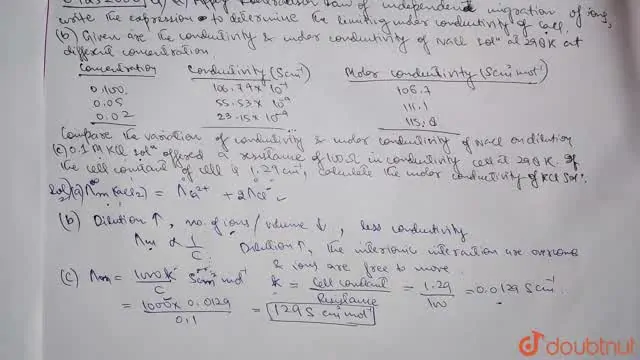(a) Apply Kohlrausch law of independent migration of ions, write the expression to determine the limiting molar conductivity of calcium chloride.
(b) Given are the conductivity and molar conductivity of NaCI solutions at 298 K at different concentrations :

Compare the variation of conductivity and molar conductivity of NaCI solutions on dilution. Give reason.
(c) 0.1 M KCI solution offered a resistance of 100 ohms in conductivity cell at 298 K. If the cell constant of the cell is 1.29cm−1, calculate the molar conductivity of KCI solution.
(a) ∧∘m(CaCI2)=λ0Ca2++2λ0CI−
(b) Conductivity of NaCI decreases on dilution as the number of ions per unit volume decreases.
Whereas, molar conductivity of NaCI increases on dilution as on dilution the interionic interacitons are overcome and ions are free to move.
(c) G∗=kR
k=1.29100=0.0129 S cm−1
∧m=1000kC
∧m=1000×0.01290.1
∧m=129 S cm2mol−1
Related Playlists
- BOOK - XII BOARD PREVIOUS YEAR PAPER ENGLISHCHAPTER - XII BOARDSEXERCISE - SET- I34videos
XII BOARDS
- BOOK - XII BOARD PREVIOUS YEAR PAPER ENGLISHCHAPTER - XII BOARDSEXERCISE - SET- II10videos
XII BOARDS
- BOOK - XII BOARD PREVIOUS YEAR PAPER ENGLISHCHAPTER - XII BOARDSEXERCISE - QUESTION PAPER (SECTION-B)10videos
XII BOARDS
- BOOK - XII BOARD PREVIOUS YEAR PAPER ENGLISHCHAPTER - SAMPLE PAPER 2019EXERCISE - SECTION: D1videos
SAMPLE PAPER 2019
Similar Questions
0.05MNaOH solution offered a resistance of 31.6 ohm in a conductivity cell at 298 K. If the cell constant of the cell is 0.367cm_1 calculate the molar conductivity of the NaOH solution.
View SolutionLimiting molar conductivity of NaBr is
View SolutionExpress the relation between.conductivity and molar conductivity of a solution.
View SolutionDefine the term molar conductivity.
View SolutionWhat is meant by limiting molar conductivity?
View SolutionA 0.05 M NaOH solution offered a resistance of 31.6 ohms in a conductivity cell. If the cell constant of the conductivity cell is 0.378 cm−1, determine the molar conductivity of sodium hydroxide solution at this temperature.
View SolutionThe resistance of 0.01 M NaCl solution at 25°C is 200 ohm.The cell constant of the conductivity cell used is unity. Calculate the molar conductivity of the solution.
View SolutionThe molar conductivity of strong electrolyte
View SolutionA 0.05 M NaOH solution offered a resistance of 31.6 Ω in a conductivity cell at 298 K. If the cell constant of the conductivity cell is 0.367 cm−1, find out the specific and molar conductance of the sodium hydroxide solution.
View SolutionDefine molar conductance
View Solution


